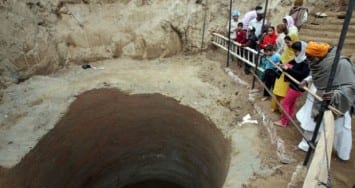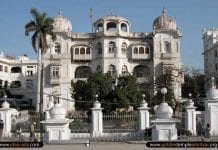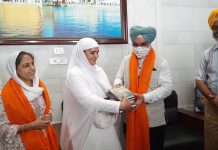

 AMRITSAR, Punjab— Parkash Badal’s government’s decision to construct a memorial to the 282 soldiers who supposedly died in the 1857 mutiny triggered against the then British rulers, is being questioned, and challenged by various quarters on the basis of historical facts. Remains of those soldiers have been dug out from a well namely “Kalian wala Khuh” recently at a Sikh shrine in Ajnala. Badal’s plan is to the construct a Gurdwara in memory of those deceased soldiers, but is opposed by Sikh circles particularly.
AMRITSAR, Punjab— Parkash Badal’s government’s decision to construct a memorial to the 282 soldiers who supposedly died in the 1857 mutiny triggered against the then British rulers, is being questioned, and challenged by various quarters on the basis of historical facts. Remains of those soldiers have been dug out from a well namely “Kalian wala Khuh” recently at a Sikh shrine in Ajnala. Badal’s plan is to the construct a Gurdwara in memory of those deceased soldiers, but is opposed by Sikh circles particularly.
Several Indian and British historians have claimed that the 282 soldiers were not Sikhs, but belonged to Bengal or Awadh (Purbis).
A noted Sikh historian Dr. Kirpal Singh, who has been awarded with the title of ‘Professor of Sikhism’ by Sri Akal Takht Sahib, has brought the facts to fore front that these soldiers worked against the interest of Punjab, and Sikh principles, and also robbed the honor of Sikh women, and that there should be no memorial for such dead persons.
Meanwhile, Dal Khalsa has issued a statement that the gurdwara built in the name of these soldiers in Ajnala is against the tenets of Sikhism. It said soldiers were neither Sikh, nor did they die for the cause of the Sikh religion. Hence raising a gurdwara in their name is anti-gurmat, going against Sikh principles.
Taking a jibe at the Badal Dal, the Dal Khalsa’s office secretary Bhai Sarabjit Singh Ghuman said, “Those soldiers who became part of British army, and participated in Anglo-Sikh war to end the rule of Maharaja Ranjit Singh, are being praised in the regime of Parkash Badal, who claimed that he was running his government in the lines of the Maharja’s rule.”
He said the mortal remains exhumed from the well were not of any Sikh, nor Punjabi. He said revelations made by well- known historians, and experts, should be an eye-opener for all political parties, and individuals, and that they should stop terming these soldiers as “martyrs” as their conduct, and character, lacked morality. He added that even if the dead deserve to be counted, yet we have to see on which side. These soldiers remain on the wrong side in the history.
Referring to his research, which he documented in his book, The Last Sunset: The Rise & Fall of the Lahore Durbar, Capt. Amarinder Singh, former CM of Punjab argues that constructing a Gurdwara would be inappropriate since none of those martyred by the British were either a Sikh, or Punjabi. While three formations of Indian soldiers were disarmed, those from the 26th Native Infantry Regiment revolted, and left the barracks after killing two British officers at the Mian Mir cantonment near Lahore, he says.
Capt. Singh’s book, which deals with the reign of Maharaja Ranjit Singh, and the annexation of the Sikh empire after the Anglo-Sikh wars, says that the 26th Native Infantry Regiment, raised in Awadh, was composed mainly of Brahmins, a fact which finds mention in accounts preserved in the National Archives. It was part of the 5th Infantry Brigade of the British Army, led by Thomas Ashburnham, at the Battle of Sobraon, in which the legendary Sikh general Sham Singh Attari laid down his life on February 10, 1846, during the first Anglo-Sikh war.
However, the book, and other accounts, are silent on the possibility that the same soldiers of the 26th Native Infantry Regiment who took part in the Anglo-Sikh wars in 1846 also revolted in 1857. Accounts say that of the 500 who revolted at Mian Mir, 218 were killed at Dadiyan, and 282 were apprehended, and brought to Ajnala, where, at the orders of the then Deputy Commissioner of Amritsar, F.H. Cooper, they were executed by a firing squad, and the bodies dumped in the well from where the remains were exhumed earlier this month.




